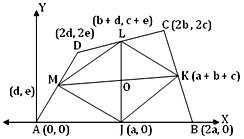Subscribe to our ▶️ YouTube channel 🔴 for the latest videos, updates, and tips.
Quadrilateral form a Parallelogram
Statement of the Theorem: Prove that the lines joining the middle points of the adjacent sides of a quadrilateral form a parallelogram.
Proof: Let ABCD be a quadrilateral and length of its side AB is 2a.
Let us choose origin of rectangular cartesian co-ordinates at the vertex A and x-axis along the side AB and AY as the y-axis. Then, the co-ordinates of A and B are (0, 0) and (2a, 0) respectively. Referred to the chosen axes, let (2b, 2c) and (2d, 2e) be the co-ordinates of the vertices C and D respectively. If J, K, L, M be the mid-points of the sides AB, BC, CD, and, DA, respectively, then the co-ordinates of J, K, L and M are (a, 0 ), (a + b, c), (b + d, c + e) and (d, e) respectively.
Now, the co-ordinates of the mid-point of the diagonal JL of the quadrilateral JKLM are {(a + b + d)/2, (c + e)/2}
Again, the co-ordinates of the mid-point of the diagonal MK of the same quadrilateral are {(a + b + d)/2, (c + e)/2}.
Clearly, the diagonals JL and MK of the quadrilateral JKLM bisect each other at ((a + b + d)/2, (c + e)/2). Hence, the quadrilateral JKLM is a parallelogram. Proved.
● Co-ordinate Geometry
- What is Co-ordinate Geometry?
- Rectangular Cartesian Co-ordinates
- Polar Co-ordinates
- Relation between Cartesian and Polar Co-Ordinates
- Distance between Two given Points
- Distance between Two Points in Polar Co-ordinates
- Division of Line Segment: Internal & External
- Area of the Triangle Formed by Three co-ordinate Points
- Condition of Collinearity of Three Points
- Medians of a Triangle are Concurrent
- Apollonius' Theorem
- Quadrilateral form a Parallelogram
- Problems on Distance Between Two Points
- Area of a Triangle Given 3 Points
- Worksheet on Quadrants
- Worksheet on Rectangular – Polar Conversion
- Worksheet on Line-Segment Joining the Points
- Worksheet on Distance Between Two Points
- Worksheet on Distance Between the Polar Co-ordinates
- Worksheet on Finding Mid-Point
- Worksheet on Division of Line-Segment
- Worksheet on Centroid of a Triangle
- Worksheet on Area of Co-ordinate Triangle
- Worksheet on Collinear Triangle
- Worksheet on Area of Polygon
- Worksheet on Cartesian Triangle
11 and 12 Grade Math
From Quadrilateral form a Parallelogram to HOME PAGE
Didn't find what you were looking for? Or want to know more information about Math Only Math. Use this Google Search to find what you need.



New! Comments
Have your say about what you just read! Leave me a comment in the box below. Ask a Question or Answer a Question.